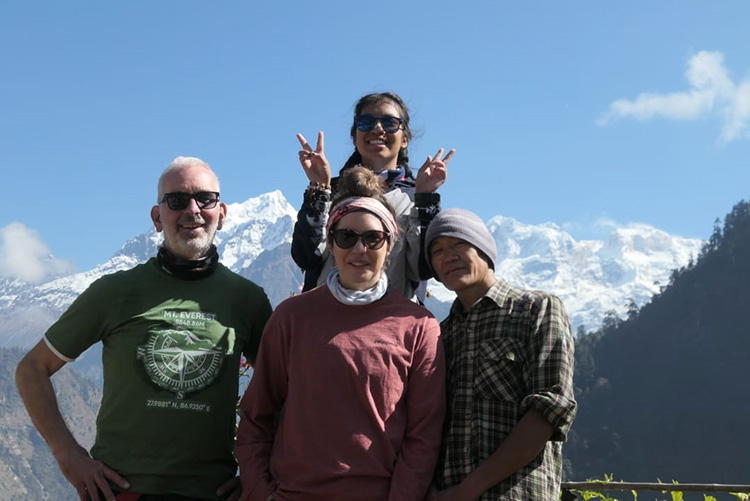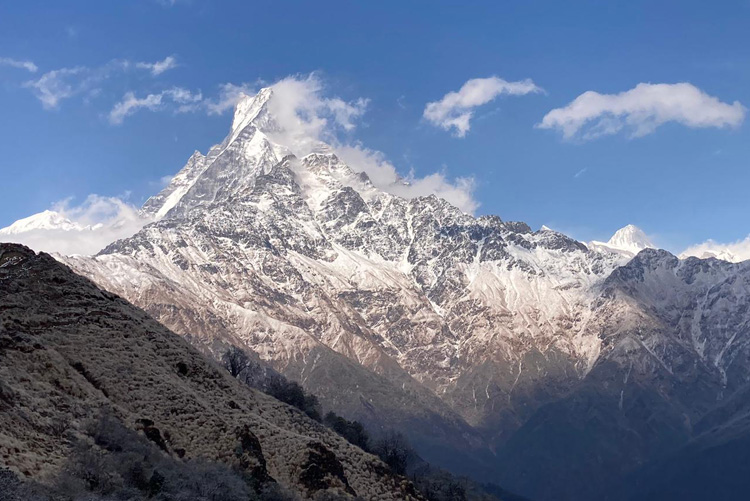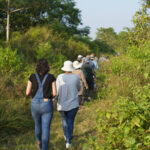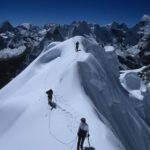
Annapurna Circuit Trekking
Annapurna Circuit Trekking is one of the best ways to get to know the mountains in Nepal. If that’s the only reason you want to visit the area, this is where you should start. The area around Annapurna is a trekker’s dream. The trek is worth it because it takes you on beautiful paths with teahouses, Tibetan temples, subtropical lowlands, and big, sharp mountain peaks.


The best-known route in the area is the Annapurna Circuit, which has a long history. It goes all the way around the Annapurna Massif and is often on lists of the top 10 treks on the planet. Along the 190 km Annapurna circuit, you gain a lot of height. It starts at 760m in a small town called Besisahar. At its highest point on Thorong La Pass, it is 5,416m high.
The Annapurna Circuit is one of, if not the best trek in all of Nepal. This classic circuit is a trip that is very different and very beautiful. Dramatic deep gorges, bleak high mountain passes, Buddhist temples, beautiful farming villages, and all of the Annapurna Massif’s major mountains.
“Mountains are the beginning and the end of all natural scenery.”
By John Ruskin
Table of Contents
- What Is Annapurna Circuit Trek
- Best Time For Annapurna Circuit Trek
- How Long Is Annapurna Circuit Trek
- How High Is Annapurna Circuit
- Annapurna Circuit Trek Difficulty
- Annapurna Circuit Trek And Temperature
- What To Bring On Annapurna Circuit Trek
- Annapurna Circuit Terrain
- Accommodation During The Annapurna Circuit Trek
- Food During The Annapurna Circuit Trek
- Views During The Annapurna Circuit Trek
What is Annapurna Circuit Trekking
The Annapurna Circuit is a long trail that goes around the Annapurna mountains. Depending on the route you take, it can take anywhere from 12 to 22 days and be between 160 and 230 kilometers long.
For instance, you can take a side trip to the Annapurna Sanctuary and then come back to the circuit, but it will add days to your trip. You can also go faster if you stay on dirt roads that the government built in a controversial way. This means that you can’t enjoy the beautiful high mountain passes. But for many, this defeats the purpose of the trip. The best views are from the high trails.
On the circuit, you can see beautiful views of the Annapurna mountains, which are named Annapurna I, Annapurna II, Annapurna III, and Annapurna 75 (just kidding, it’s Annapurna IV), as well as the 8,167m Dhaulagiri, the Machhapuchhre, and many other peaks over 6000m.
Best time for Annapurna Circuit Trekking


It is very important to go trekking in Annapurna or to hike the Annapurna Circuit at the right time of year. The Annapurna Circuit is best hiked from October to November or from April to May. During these times, it’s usually not too wet, the skies are clear, and it’s not too cold up high.
In the winter, between these two seasons, things are often clear and the scenery is beautiful, but thick snow can close Thorong La Pass for days at a time.
June through September is the rainy season, and this is usually when the circuit is the least busy. Even though it’s called “the rainy season,” it doesn’t rain as much as you might think. Most of the trail is in a rain shadow, so the northern parts of the trail are actually pretty dry. However, the southern part of the trail gets very wet. There are a lot fewer people around at this time of year, and the flowers are in full bloom, but clouds are more likely to block your view of the scenery.
How long is Annapurna Circuit Trek
The Annapurna Circuit trail is great because, since it’s a loop, you won’t see the same views twice.
Most of the time, the trek begins in the subtropical town of Besisahar and ends in Pokhara. Most of the time, people hike the Annapurna Circuit counterclockwise. This means that each day, you gain a lot less height. This is just one reason why crossing Thorong La Pass this way is much safer.
As was already said, each trip on the Annapurna Circuit will be different. Some people take short cuts or detours. Some people take longer to get used to a new place. Some people take a day off to rest and get better. So, every trip is different, but here is a typical 16-day plan for the Annapurna Circuit. From the first day to the 16th:
- Day 1: Drive from Kathmandu to Syange (1140m) via Besisahar (8,23m) Duration: 7-9 hours.
- Day 2: Trek from Syange to Dharapani (1,860m) Duration: 6-7 hours.
- Day 3: Trek from Dharapani to Chame (2,715m) Duration: 5-6 hours.
- Day 4: Trek from Chame to Pisang (3,240m) Duration: 4-5 hours.
- Day 5: Trek from Pisang to Manang (3519m) Duration: 5-6 hours.
- Day 6: Acclimatization day at Manang.
- Day 7: Trek from Manang to Yak Kharka (4,018m) Duration: 4-5 hours.
- Day 8: Trek from Yak Kharka to Thorong Phedi/ High Camp (4,900m) Duration: 4-5 hours.
- Day 9: Trek from Thorong Pedi via Thorong La Pass (5416m) to Muktinath (3802m) Duration: 7-9 hours.
- Day 10: Trek from Muktinath to Marpha (2,670m) Duration: 5-6 hours.
- Day 11: Trek from Marpha to Lete (2,480m) 5-6 hours.
- Day 12: Trek from Lete to Tatopani (1,190m) Duration: 5-6 hours.
- Day 13: Trek from Tatopani to Ghorepani (2,750m) Duration: 6-8 hours.
- Day 14: Hike to Poon Hill (3,210m) & trek to Tikhedhunga (1,500m ) Duration: 5-6 hours.
- Day 15: Trek from Tikhedhunga to Nayapul (1100m) & drive to Pokhara (8,50m) Duration: 4-5 hours.
- Day 16: Drive from Pokhara to Kathmandu (1,350m) Duration: 6-7 hours.
How high is Annapurna Circuit
In terms of altitude, you can’t really prepare for this trek in the same way you would for city trekking. About 2500 m above sea level, you may start to feel the lack of oxygen. It’s a good idea to plan your trek day by day with this in mind and give yourself a day or two to get used to the higher altitude. It has different effects on everyone. To give you an idea, there is only half as much oxygen at the highest point of the Annapurna Trail (Thorong La Pass, 5416m) as there is at sea level. Guides who are well-trained and have a lot of experience are very helpful in this area. They can help you go up the mountain at the right speed and get you to safety if you have to turn around.
Unfortunately, getting used to a new place is just as important as all those annoying articles on the internet say it is. This is why you shouldn’t rush through your trip.
The fact that you have to be fit to do the Annapurna Circuit shouldn’t stop you, though. If your mind is strong and you’re in good shape, you should be able to do well even if you don’t have any experience. It’s not a very difficult trek, and if you plan and pace yourself well, you can take your time.
Annapurna circuit trek difficulty
Is the Annapurna Circuit hard? Is a piece of string long? When we were six, we asked Santa for a pink bike with a basket and tassels. Why didn’t he bring it? Who can say? The Annapurna Circuit is hard depending on your fitness, mentality, and route as well as your experience.
Now that there are dirt roads, more people are starting to cut days off the beginning of their journey. You can now get in a jeep and drive to a place where you used to have to walk for days (is that cheating?). If you don’t want to take the whole mountain trail, you can often follow faster dirt roads and still see beautiful views. If you choose the right guides, they’ll make sure you see all the sights you want to see instead of just sticking to dirt roads.
Any trek that goes all the way around the Annapurna Circuit is going to be hard. Any hike that lasts more than ten days will require you to be in good shape. But for the most part, you get to take it easy, have fun, and sit by the fire in the evenings. Most days start early and end in the afternoon, and most days have hikes that last between five and seven hours.
Many people also hire a porter to help them carry their bags, which takes some of the load off. In this case, though, it’s important to find the right local guide. It makes sure that the porters you hire are paid and cared for fairly, and that they have the right training and can only carry a certain amount of weight.
Annapurna circuit trek and temperature
During the winter, the average daytime temperature on the Annapurna Circuit trek is between 5 and 10°C, but it can get as low as -20°C at higher altitudes and even lower at night.
During the warmer months, temperatures at lower altitudes on the trek are likely to be between 15°C and 23°C (below 2,500m). But if you go above 4,000 m, the temperature will drop below 10°C. And it could be very cold at Thorung La, the highest point of the trek. So you’ll need warm clothes even in the summer.
What to bring on Annapurna Circuit Trek
With temperatures that vary so much, you need to make sure you have the right gear with you, like tried-and-true hiking boots, good waterproofs, and a down jacket. A sleeping bag from a fake brand that you bought on a backpacking trip won’t work in the Himalayas.
If you can, you should also bring a metal flask for water. If you have a plastic water bottle and the water isn’t heated, it’s likely to freeze if you go somewhere cold. If you can bring something to clean the water, that’s even better. Bottled water gets more expensive as you go higher.
It’s the same with food. Once the roads end on the mountain, dinner may cost four times as much as it would have in Kathmandu. Also, there are no ATMs until Jomson, so be sure to bring cash.
Annapurna Circuit Terrain


This 300-kilometer trek is hard but worth it. It goes counterclockwise through the Marsyangdi Valley and ends at the Thorung La Pass, which is 5412m above sea level. It is one of the most popular treks in Nepal because it has beautiful deep valleys and great mountains.
The Annapurna Circuit trek has a variety of conditions, but most of the walk is on well-worn paths and not too high. The highest point of the trip, both in terms of altitude and the amazing views of the mountains, is when you cross the Thorong La. On average, a day’s walk will take 5 hours and be on ground that goes up and down. Some days are longer and some are shorter.
As the name suggests, the trail goes around Mount Annapurna (8091m), which offers a wide range of landscapes, people, and cultures. You’ll pass through charming Gurung villages and trek through subtropical jungles before reaching a high, dry area that looks like Tibet.
Accommodation during the Annapurna Circuit Trek
The local families from the area run the lodges where the trekkers can stay. In the middle of each lodge is a common room with a large stove that heats the room and makes it feel cozy. The bedrooms don’t have heat, and there are usually two beds in each room, each with a mattress, pillows, and a blanket. You will need to bring a sleeping bag and a pillow case. A three-season sleeping bag is usually enough.
Most of the lodges have gas-powered showers, and most of the toilets are sit-down flush toilets (some lodges do also have squat toilets). The food at the lodges is very good. It is a mix of traditional Nepalese food and western dishes. People often eat burgers and fries or dal bhat with rice. In the lodges and shops, you can buy everything from fresh pastries to beer, stir fries to deep-fried Mars bars. Here is a price list for Nepal. There are also a lot of shops that sell drinks, snacks, candies, and chocolate. You can also buy any gear you forget on the trail or in Kathmandu.
Food during the Annapurna Circuit Trekking
This trekking route has a variety of food options. The tea houses provide a clean and tasty meal. The most popular dish is Dal Bhat curry (rice with lentil soup and curry). However, fried rice, eggs, noodles, pizzas, sizzlers, Yak steak, Yak Burger, and many other dishes are available.
There are also numerous bakeries. Manang has about four bakeries. The bread made locally is delicious. There are also one or two bakeries ahead of Manang. As part of the drinking menu, you can order tea, coffee, hot chocolate, juice, soup, and other items. At such altitudes, alcohol is not advised. There is also a nice tea house at Thorong La pass.
Views during the Annapurna Circuit Trekking
The Annapurna Circuit trail goes between the world’s seventh- and tenth-highest peaks, Dhaulagiri (8167m) and Annapurna (8091m). The Annapurna Circuit Trekking gives you amazing views of mountains like Gangapurna, Lamjung Himal, Manaslu, Pisang Peak, Chulu East, Chulu West, Nilgiri, and Tukuche Peaks, as well as Machhapuchhre, also known as the Fishtail.
Also, you will walk through the Kali Gandaki Gorge. At Andhagalchhi, between the Annapurna and Nilgiri mountains, is the deepest gorge in the world (2,520m). The valley is more than 5,000 meters below the top of Mt. Annapurna. The Annapurna Circuit is one of the best things you can do in your life.
Useful Reading
- The Best Time For Annapurna Base Camp Trek
- How to Prepare For The Annapurna Base Camp Trek
- Annapurna Base Camp Trek Itineraries
- Ghorepani Poonhill Trek
- The Best Annapurna Treks










